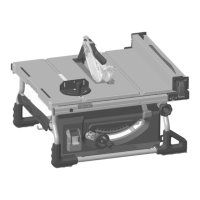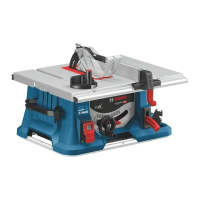-44-
Making a Featherboard
(Fig. 64)
A featherboard should be made from a straight
piece of wood that is free of knots or cracks. Fig.
64 shows typical feather board dimensions.
The kerf, A, should be about 1/4” (6.35 mm)
apart.
Making an Auxiliary Fence
(Fig. 62, Fig. 63)
Make the Auxiliary Fence 95 using pieces of 3/8”
(8.7 mm) plywood, A, and 3/4” (19 mm) hard-
wood, B. Fasten together with glue and wood-
screws.
NOTE: Since a Push Block 94 is used with the
Auxiliary Fence 95, the 4-3/4” (120.6 mm) di-
mensions must be identical on both pieces.
Basic Table Saw Operations
45°
notch
93 93
1-1/2” (38 mm)
1/4” (6.4 mm)
A
B
C
3/4” (19 mm)
15” (381 mm)
D
A
B
B
B
C
D
workpiece
end
Fig. 61
These edges must
be parallel.
4-3/4” (120.6 mm)
3/8” (9.5 mm)
12” (305 mm)
3/8” (8.7 mm) plywood
3/4” (19 mm) hardwood
94
94
A
A
C
C
F
B
B
D G
E H
2-1/2” (63.5 mm)
5-1/8” (130 mm)
5” (127 mm)
D
E
E
F
F
G
H
Fig. 62
This face
and this
edge
must be
parallel.
95
21-1/2” (546 mm)
4-3/4” (120.6 mm)
3/8” (8.7 mm) plywood
3/4” (19 mm) hardwood
A
C
C
F
B
D
E
2-1/4” (57.2 mm)
5-1/2” (139.7 mm)
B
A
D
E
F
Fig. 63
B
C
25” (635 mm)
8” (203 mm)
3/4” (19 mm)
D
E
F
4-1/2” (114 mm)
5” (127 mm)
A
B
C
kerf about 1/4” (6.35 mm)
D
E
F
A
Fig. 64
D
D
1609B07947GTS18V-08 OSI 08-2022.indd 44 8/3/22 2:44 PM

